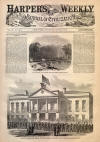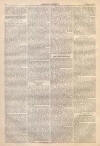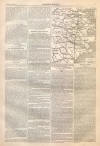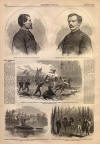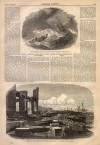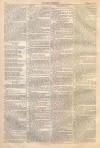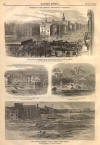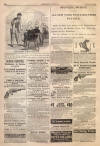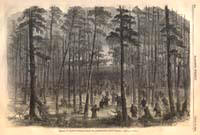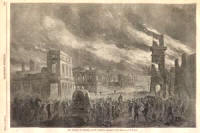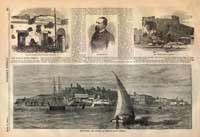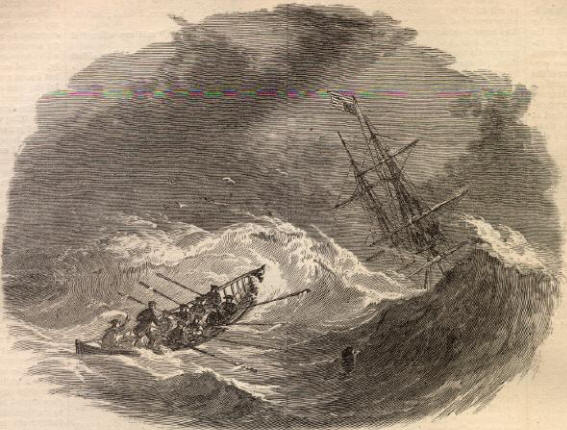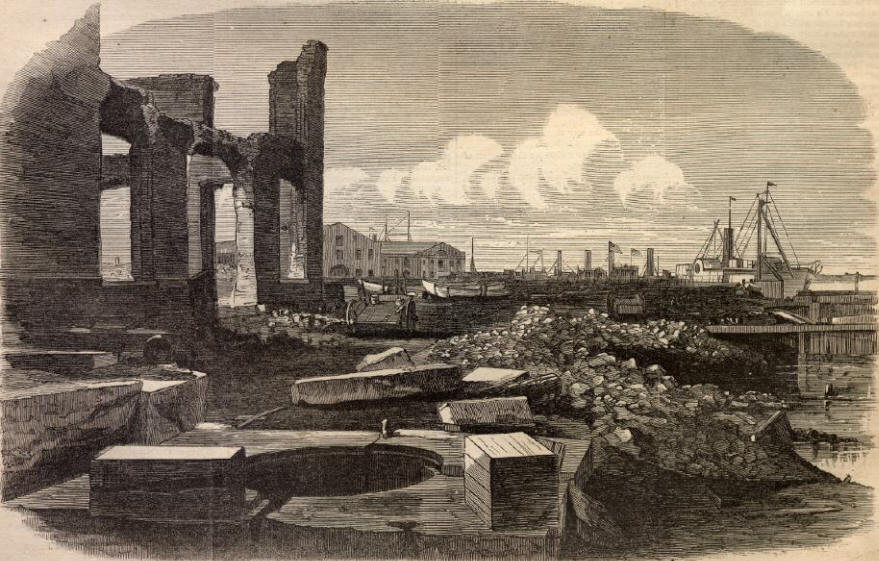|
This Site:
Civil War
Civil War Overview
Civil War 1861
Civil War 1862
Civil War 1863
Civil War 1864
Civil War 1865
Civil War Battles
Confederate Generals
Union Generals
Confederate History
Robert E. Lee
Civil War Medicine
Lincoln Assassination
Slavery
Site Search
Civil War Links
Revolutionary War
Mexican War
Republic of Texas
Indians
Winslow Homer
Thomas Nast
Mathew Brady
Western Art
Civil War Gifts
Robert E. Lee Portrait
|
(Previous
Page) mand of a brigade of the Ninth
Corps, which he accompanied to the West in the spring of 1863. In the movement
on Knoxville he acted as Chief Engineer of the Twenty-third Corps. He took a
prominent part in defense of Knoxville against
LONGSTREET. He it was who
constructed Fort Sanders, which was held against the rebel assault of November
29. In all of SHERMAN'S campaigns since the spring of 1864 Colonel POE has acted
as Chief Engineer on his staff. He is now Brevet Colonel in the Regular Army.
The graphic sketch on page 212 of
the charge made at White Pond by the First Alabama and Fifth Kentucky, under the
command of Colonel SPENCER, deserves particular mention. The First Alabama was
organized at Corinth, Mississippi, early in 1863. During the grand campaign
against Atlanta this regiment accompanied the Army of the Tennessee, rendering
signal service to the lamented General M`PHERSON up to the time of the
evacuation of Kenesaw Mountain by the enemy, when it was ordered to Rome on
scouting duty. During the movements of HOOD upon our rear this regiment rendered
most invaluable information to
Gen. SHERMAN, their superior knowledge of the
topography of the country, together with their peculiar Southern familiarity
with the inhabitants, greatly aiding them in obtaining the most accurate news of
the enemy's designs. In the ranks of this regiment are to be found some of the
original true blue Southern Unionists, among whom are three exmembers of the
last Alabama Union
Legislature, two or three
ministers,
two lawyers, besides a large
number of intelligent mechanics.
On the same page are
illustrations of the first boat which, under the management of Captain
AINSWORTH, established communication by way of the Cape Fear River with General
SHERMAN'S army, and of the two officers GRINNELL and COLBY and their march
through the swamps, bearing dispatches for General SHERMAN. Lieutenant H. W.
GRINNELL and Ensign H. B. COLBY left their ship, the Nyack, at Wilmington March
4. They traveled in the full naval uniform, accompanied by two Jack tars in
sailors' rig, and with two negro guides succeeded in making their way through
the swamps and forests to General SHERMAN, whose they reached on March 12. The
only determined attack made upon them was within ten or twelve miles of our
lines, when two of SHERMAN'S " bummers," mounted on their mules and armed with
Springfield muskets, charged wildly down upon these six well armed men, ordering
them to surrender instantly or they'd blow their heads off." The mistake was
soon rectified, and the entire party came into SHERMAN'S lines. Upon their
return to their ship at Wilmington they were received with hearty cheers by the
Jack tars, who never fail to appreciate a brave and successful undertaking.
RESCUE OF THE CREW ON THE
"ENTERPRISE."
WE give in the adjoining
illustration an interesting picture of the rescue of the crew on board the
Enterprise, by the boat of the Richmond, in Mobile Bay. The vessel was lost on
the 15th. Our artist says :
" The captain and all the crew
save one were safely taken off by our fifth cutter, led by Mr. FLOYD, our
boatswain, than whom a braver man scarce lives. Three times was his boat
swamped, but these brave men as often hauled her through the breakers upon the
beach, righted and baled her out, and dashed into the wild waters. For nearly
twenty-four hours they were unceasingly endeavoring to save the men in the
brig's tops, and did not leave until the last man was in their boat. The
Enterprise left New York on the 24th of January, and the captain was about 100
miles off here when she sprung a leak. Knowing well that his vessel could not
live through the storm, leaking as it was, he directed his course to this bay,
thinking it better to try to get near succor than to run away from it. He knew
this channel well, and had he kept but two ships' lengths to the westward would
have come into the haven."
RUINS OF THE NORFOLK NAVY YARD.
THE war has left nowhere more
permanent traces of its destructive work than at the Norfolk Navy yard, which
was one of the first objects against which the Confederate revolutionists lifted
treasonable hands. We reproduce from a photograph an illustration truthfully
showing the present aspect of the place. In 1861 the Norfolk Navy yard was
filled with the maritime and military wealth of the nation, and within its
limits were the most extensive and complete array of shops, foundries, ship
yards, mills, and docks in the country. Here, at that time, were twelve vessels
of war of various sizes, from the Pennsylvania of 120 guns to the little brig
Dolphin of 4. It will be remembered that among these was the Merrimac, a steam
frigate of 40 guns, which was afterward changed into an iron clad ram ; and here
also was the sloop Cumberland, which this same ram, in 1862, sent to the bottom
of the sea. In addition to these vessels there were in the yard 2500 pieces of
heavy ordnance, 300 of which were Dahlgren guns. The quantity of small arms and
ammunition was immense; at old Fort Norfolk, which was used as a magazine, there
were three hundred thousand pounds of powder. The
value of the military property of
the yard was estimated at not less than thirty-five millions of dollars.
Commodore M'AULEY was in command of the yard at that time, but delayed to remove
the property until it was too late, and he was compelled to destroy it. But the
destruction was partial. Nearly all the ordnance and all the immense store of
powder fell into the hands of the rebels.
THE SPRING FRESHETS.
THIS spring the mountains have
paid to the sea an unusual tribute. Owing to the unprecedented fall of snow
during the winter the freshets throughout the country have been greater than for
a generation past, and have been very disastrous. The Hudson, the Mohawk, the
Connecticut, the Susquehanna, and all our great rivers, have been swollen with
the flood to an almost incredible volume, which has overflowed the land and
carried away houses and destroyed factories, and even robbed grave yards of
their quiet inhabitants. It is almost impossible to estimate in money the losses
which have been sustained.
The Susquehanna, in its sudden
rise, tore away hundreds of miles of the Erie Railroad, swept off valuable
railroad bridges, submerged a good portion of the city of Harrisburg, and
carried away vast quantities of lumber stored along its banks. Its tributaries
the Chemung, Chenango, and Juniata, in Western New York and Pennsylvania carried
a like destruction in their path. Two-thirds of Elmira, on the Chemung, were un-
der water, and the furniture and
people had to be removed in boats. The Genesee River rose at one time at the
rate of a foot an hour, and the central and business portion of Rochester, on
the west side of the river, was completely inundated. The Erie canal overflowed.
The flood swept through the streets. We give on page 220 two illustrations of
the flood in Rochester. The following description is given by the Rochester
Daily Union :
At least nine-tenths of the
streets in the First Ward were under water, and many in the Second and other
Wards. On Main Street during all that day thousands stood looking over the flood
upon Buffalo Street. And on Buffalo Street, west of Washington, a vast crowd
stood looking eastward over a third of a mile of water, the eastern part of
which was surging and boiling as if thrown up by some mighty engine below. On
Exchange Street, below the Clinton Hotel, people were looking anxiously
northward into State Street, submerged to the depth of from one to four feet for
half a mile. On State Street, near Engine House No. 3, a multitude gazed
southward upon a sea extending to the heart of the city, and in many other
streets similar scenes were presented. Small boats could be seen in nearly all
the streets, and now and then teams were driven through some of them. People
were (Next Page)
THE "RICHMOND" RESCUING THE CREW OF THE
"ENTERPRISE," FEBRUARY 15, 1865.
RUINS OF THE NORFOLK NAVY-YARD.—[PHOTOGRAPHED BY A.
GARDNER, WASHINGTON, D. C.]
|
